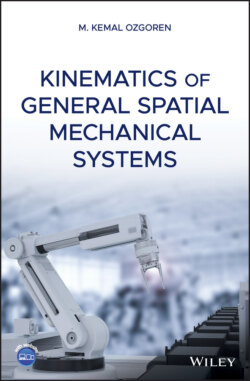Читать книгу Kinematics of General Spatial Mechanical Systems - M. Kemal Ozgoren - Страница 29
2.1 Vector Equation of Rotation and the Rodrigues Formula
ОглавлениеFigure 2.1 illustrates the rotation of a vector into another vector by an angle θ about an axis described by a unit vector .
Incidentally, a vector may be acted upon, simultaneously or successively, by two kinds of displacement operators. One of them is a rotation operator, which is defined as an operator that changes only the orientation of a vector irrespective of any possible change in its location. The other one is a translation operator, which is defined as an operator that changes only the location of a vector without changing its orientation.
As mentioned above, a rotation operator is not affected by any translational displacement. Therefore, without any loss of generality, the rotation of is illustrated in Figure 2.1 so that the point O (i.e. the tail point of ) is assumed to be fixed and the rotation axis is assumed to pass through that point. Moreover, as illustrated on the left‐hand side of Figure 2.1, the vector moves on the surface of a cone while it is rotated into the vector . The projected appearance of this rotation on the base of the mentioned cone is illustrated on the right‐hand side of Figure 2.1.
Figure 2.1 Rotation of a vector about an axis.
The rotation illustrated in Figure 2.1 can be described briefly in one of the following ways, in which the rotation operator is denoted by .
(2.1)
(2.2)
The resultant vector can be expressed in terms of the initial vector and the rotation parameters and θ as explained below.
Referring to Figure 2.1, the vectors and can be expressed as follows:
(2.3)
(2.4)
In Eqs. (2.3) and (2.4), is the common projection of and on the axis of rotation. Note that is not affected by the rotation operator because lies on the rotation axis. The vector is related to and as expressed below.
(2.5)
Referring again to Figure 2.1, the vector , which is perpendicular to and , is obtained by the following cross product.
(2.6)
Upon substituting Eq. (2.3) and noting that , Eq. (2.6) becomes
(2.7)
On the other hand, the projectional view on the right‐hand side of Figure 2.1 implies that the vector , which is coplanar with the vectors and , can be expressed as the following linear combination of and .
(2.8)
After the previously obtained equations concerning , , and are substituted, Eq. (2.8) becomes
The preceding equation can be arranged as follows:
(2.9)
Equation (2.9) is known as the Rodrigues formula, which is named after the French mathematician Benjamin Olinde Rodrigues (1795–1851).
